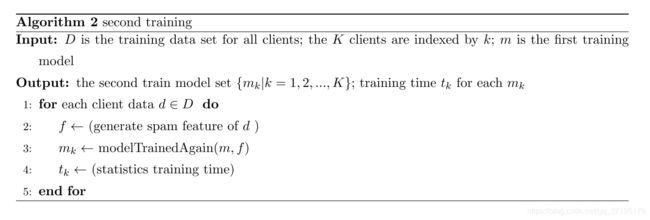论文实验伪代码
该篇文章讲述了论文实验部分的伪代码,该实验采用python语言编写,框架采用深度学习框架keras,整体实验分为一下几个部分:
0 Latex伪代码框架
\documentclass[11pt]{ctexart}
\usepackage[top=2cm, bottom=2cm, left=2cm, right=2cm]{geometry}
\usepackage{algorithm}
\usepackage{algorithmicx}
\usepackage{algpseudocode}
\usepackage{amsmath}
\usepackage{amsfonts,amssymb}
\floatname{algorithm}{Algorithm}
\renewcommand{\algorithmicrequire}{\textbf{Input:}}
\renewcommand{\algorithmicensure}{\textbf{Output:}}
\begin{document}
...伪代码内容
\end{document}
1 第一次训练(first.py)
功能实现:
根据输入的数据文件,处理数据后,切割为训练集和测试集,并在本地生成对应的文件。对整体数据,使用CountVectorizer对邮件文本进行向量化,并且生成了一个字典。用词袋模型将训练集的邮件文本数据转化为词袋特征,并用这些特征训练模型,将该模型生成本地文件。最后,加载训练集文件对模型进行评估,自此该文件运行完毕。
Latex Pseudocode:
\begin{algorithm}
\caption{first training}
\begin{algorithmic}[1] %每行显示行号
\Require $d$ is the data of first training; $K$ is cross-validation times; Algorithm SGD is named $sgd$
\Ensure the first train model $m$; $trainSet$ and $testSet$; training time $T$; evaluation result $res$
\State $(trainSet, testSet) \gets $ split($d$)
\State $S \gets $ (split $trainSet$ in equal parts of $K$)
\For {each round $t=1,2,...,K$}
\State $\left\{verify, train\right\} \gets \left\{S_{t}, S-S_{t}\right\} $
\State $(tf, vf) \gets $ (generate spam feature of $train$ and $verify$)
\State $m_{t} \gets $ modelFit($sgd, tf$)
\State $r_{t} \gets $ modelEvaluate($m_{t}, vf$)
\State $T_{t} \gets $ (statistics training time)
\EndFor
\State $m \gets $ bestModel($\left\{ (m_{t}, r_{t}) | t=1,2,...,K \right\}$)
\State $T \gets \mathbb{E}({\left\{ T_{t} | t=1,2,...,K \right\}})$
\State $test \gets $ (generate spam feature of $testSet$)
\State $res \gets $ modelEvaluate($m, test$)
\end{algorithmic}
\end{algorithm}
2 第二次训练(second.py)
Latex effect map:

Latex Pseudocode:
\begin{algorithm}
\caption{second training}
\begin{algorithmic}[1] %每行显示行号
\Require $D$ is the training data set for all clients; the $K$ clients are indexed by $k$; $m$ is the first training model
\Ensure the second train model set $\left\{m_{k}|k=1,2,...,K \right\}$; training time $t_{k}$ for each $m_{k}$
\For {each client data $d \in D$ }
\State $f \gets $ (generate spam feature of $d$ )
\State $m_{k} \gets $ modelTrainedAgain($m,f$)
\State $t_{k} \gets $ (statistics training time)
\EndFor
\end{algorithmic}
\end{algorithm}
3 平均模型与加权平均模型(avgmodel.py)
\begin{algorithm}
\caption{avgmodel}
\begin{algorithmic}[1] %每行显示行号
\Require $C$ is the model set for all clients; $w$ is the weight of each model; the $K$ clients are indexed by $k$ and $i$; $m$ is the first training model ; $d$ is the test data of second training
\Ensure average model $am$ and weighted average model $wm$; $r$ is the evaluation result of $am$ and $wm$; $t$ is the respective training and evaluation times for $am$ and $wm$
\For {each client model $c \in C$ }
\State $d_{k} \gets $ (read the data in model $c$)
\EndFor
\State $ad \gets \sum\limits_{k=1}^{K}(\frac{d_{k}}{K})$
\State $wd \gets \sum\limits_{k=1}^{K}(\frac{w_{k}}{\sum\limits_{i=1}^{K}w_{i} } \times d_{k})$
\State $(am, wm) \gets $ (set model $ad$ and $wd$ into $m$ respectively)
\State $f \gets $ (generate spam feature of $d$)
\State $r \gets $ (evaluate model $am$ and $wm$ with $f$ )
\State $t \gets $ (count the training time of $a$ and $w$ respectively)
\end{algorithmic}
\end{algorithm}

